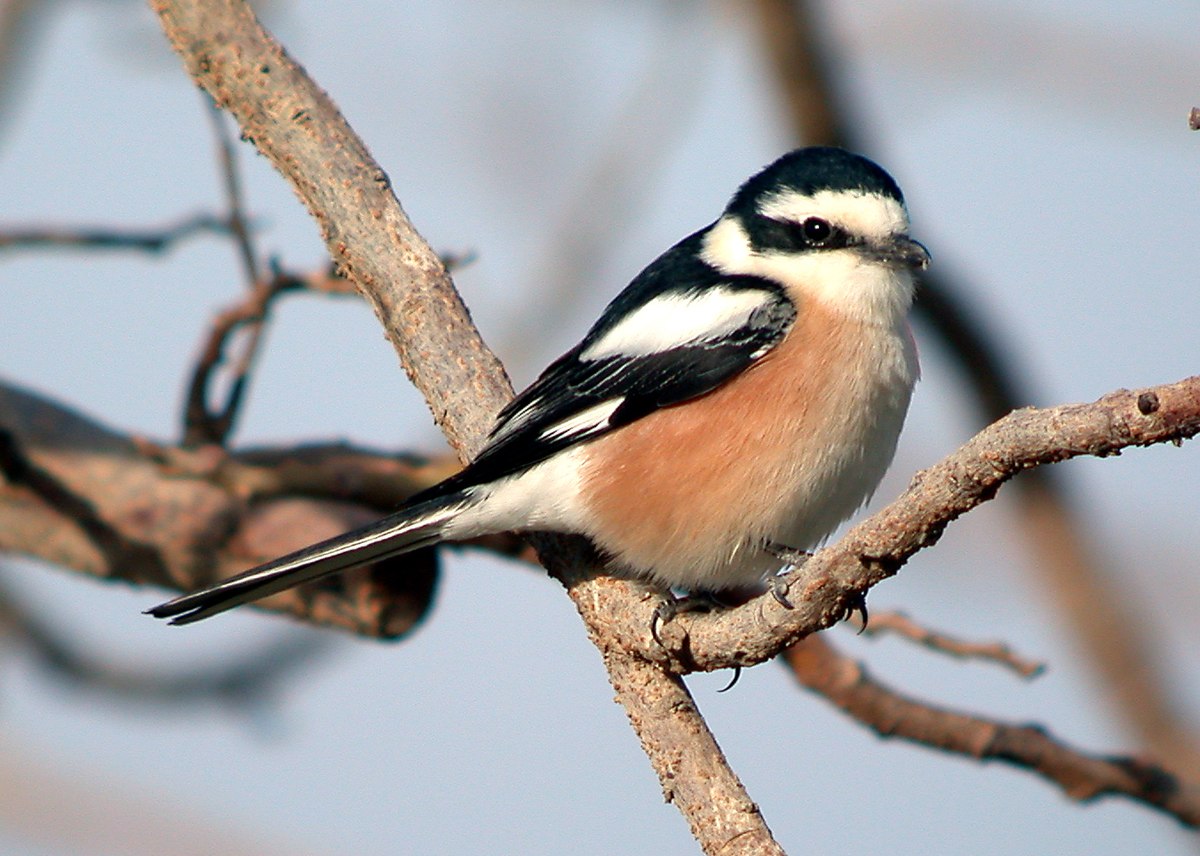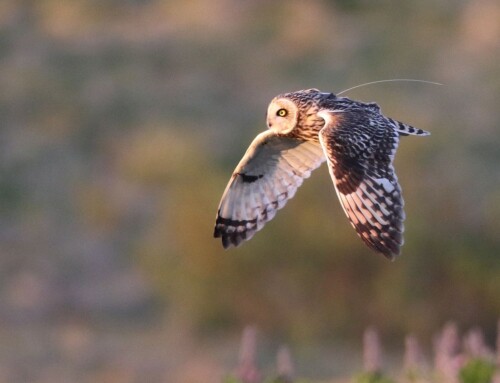 LINKED PAPER
LINKED PAPER
Split moult: a response to time constraints during the main moult period. Kiat, Y. & Izhaki, I. 2022 Ibis. doi: 10.1111/ibi.13158 VIEW
It is still very hot in Jerusalem and the days are still long but August is one of the busiest autumn migration months at the Nili and David Jerusalem Bird Observatory (JBO), operated by the Society for the Protection of Nature in Israel. A lot of migratory warblers jump on the pistacia bushes, surround the ringing station, eating the nutritious fruit which is expected to provide them with the last supply of fat before crossing the desert on their way to the wintering areas in tropical Africa.
When we look at the plumage of the passerines, as part of the ringing process done in the research station, this time of year also provides one of the best opportunities to explore the split moult. This moult pattern includes retaining some or all the secondary feathers during the main moult period (interrupted moult) and later renewal of these feathers (complementary moult), after migration. The most common species, which is characterized by this moult pattern, at this season (August) in JBO, is the Eastern Orphean Warbler (Curruca crassirostris). Adults of this species moult all primaries but no or only a few secondaries in the post-breeding period, the latter will be replaced after arriving at the wintering areas in Africa. This moult pattern represents a response to time constraints during the main moult period (Kiat and Izhaki 2021).
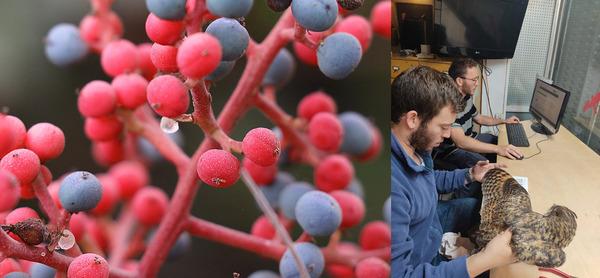
Figure 1 Pistacia fruit (left), and bird-ringing activity at the Nili and David Jerusalem Bird Observatory (JBO; right).
Berthold and Querner (1982) conducted experiments on the control of split moult in the Western Orphean Warbler (C. hortensis). The experiment included 23 individuals which were kept in light conditions simulating those to which free-living birds are exposed. In the first experimental year, the birds caught during the breeding season, and retained some unmoulted secondaries (interrupted moult), whereas, in the second experimental year, when the same birds were prevented from breeding, they moulted several weeks earlier than the previous year and then completed their moult before the migratory period. Therefore, the split moult occurred on a facultative basis as a result of various environmental pressures and short time availability, probably caused by the breeding and the need to migrate. Most of the species we meet in JBO with this moult pattern are long-distance migrants whose main moult period is post-breeding, for example, Barred Warbler (C. nisoria), Common Whitethroat (C. communis), and Masked Shrike (Lanius nubicus). White-throated Robin (Irania gutturalis) is probably the most beautiful bird in our region which is characterized by this moult pattern, but it is quite rare at JBO. However, split moult also rarely appears in long-distance migrants that regularly perform a complete moult (or interrupted, main moult) in the wintering areas, and perform moult completion during a summer moult, for example, Eurasian Golden Oriole (Oriolus oriolus), and also among short-distance migrants, for example, Red Crossbill (Loxia curvirostra), Spectacled Warbler (C. conspicillata) and Eurasian Penduline Tit (Remiz pendulinus; Kiat and Izhaki 2021).

Figure 2 White-throated Robin (Irania gutturalis) is probably the most beautiful bird in our region which is characterized by a split moult.
Although autumn is a great time to explore passerines migration at JBO, the real celebration begins in spring, when hordes of warblers and other migratory passerines make their way from Africa to the breeding areas in Europe and western Asia and make use of the natural area, located in the centre of the city, for a stopover before they continue the journey north. Two of the species that perform split moult are common at the JBO during the spring migration: Eastern Orphean Warbler and Barred Warbler; on good days dozens of them may be ringed in the research station. At this time of year, the adults of the species split their moult will show a fairly uniform and fresh wing, but a closer look will show that the secondaries moulted at the wintering areas are new and fresh than the primaries moulted at the breeding areas.
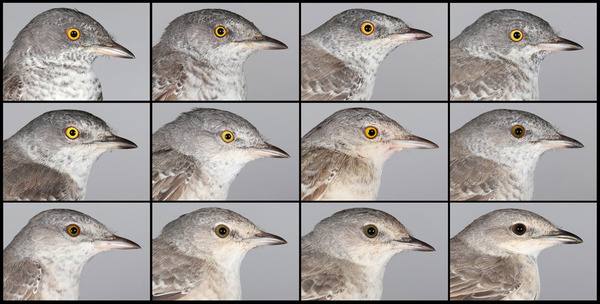
Figure 3 Barred Warblers (Curruca nisoria), one of the species characterized by split moult and regularly ringed at the JBO, all individuals in this figure were ringed in one day in spring 2021.
Unlike the uniform moult pattern in adults among the species that perform a split moult, the first-pre-breeding moult extent (number of feathers moulted; by second-year birds) is varied and greatly affected by latitude, a factor which probably represents resource availability as a result of a climatic gradient. First-year birds of the species wintering further south moulted more wing feathers than species wintering in the north of the tropical zone in Africa. The result is that most individuals of the species in which the adult performs a split moult will retain some of their nest-grown flight feathers (secondaries) for more than a year, especially those species wintering in more northern areas.
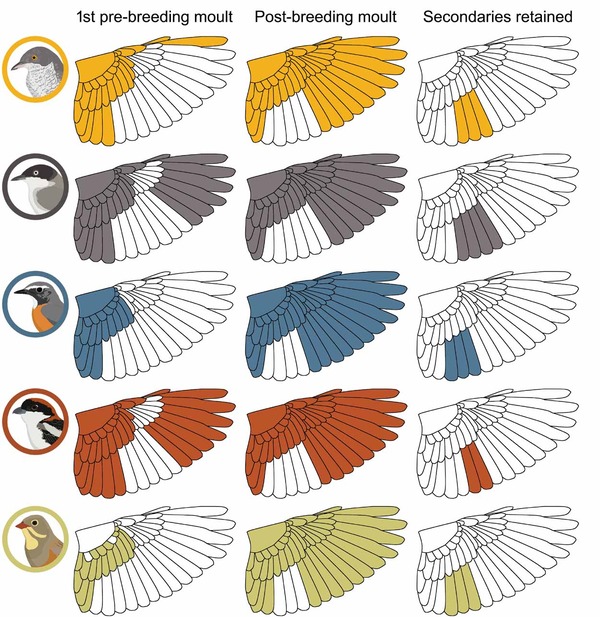
Figure 4 The degree of overlap between the first pre-breeding moult (winter moult; left column) and the post-breeding moult (central column) among the five species most characterized by the split moult (Barred Warbler, Eastern Orphean Warbler, White-throated Robin, Woodchat Shrike and Ortolan Bunting). These species have, on average, two to four secondaries retained (right column) for 14–16 months before being moulted during the second winter.
In conclusion, split moult is driven by time constraints during the main moult period, summer or winter. These constraints are more common among adults than juveniles as a result of the necessity for complete annual plumage renewal by adults (Kiat and Sapir 2017), and among summer moulters than winter moulters as a result of the limited time in the summer period (Barta et al. 2008). Split moult is probably a coping strategy for these time constraints during the main moult period and hence represents a flexible behaviour across passerine species (Kiat and Izhaki 2022).
References
Barta, Z., McNamara, J. M., Houston, A. I., Weber, T. P., Hedenström, A., & Fero, O. 2008. Optimal moult strategies in migratory birds. Philosophical Transactions of the Royal Society B: Biological Sciences 363: 211-229. VIEW
Berthold, P., & Querner, U. 1982. On the control of suspended moult in an European trans-Saharan migrant, the Orphean Warbler. Journal of the Yamashina Institute for Ornithology 14: 157-165. VIEW
Kiat, Y., & Sapir, N. 2017. Age-dependent modulation of songbird summer feather molt by temporal and functional constraints. The American Naturalist 189: 184-195. VIEW
Kiat, Y., & Izhaki, I. 2021. Split moult: time constraints or endogenous strategy? Ibis 163: 536-548. VIEW
Kiat, Y., & Izhaki, I. 2022. Split moult: a response to time constraints during the main moult period. Ibis. VIEW
Image credit
Top right: Masked Shrike (Lanius nubicus) Len Worthington CC BY SA 2.0 Wikimedia Commons.
If you want to write about your research in #theBOUblog, then please see here.


